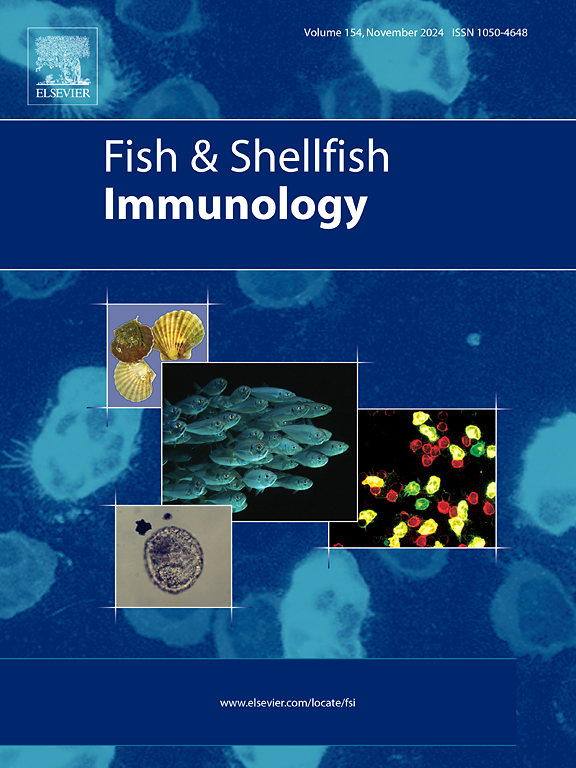温度和β-1,3-葡聚糖对凡纳滨对虾后幼体白斑综合征病毒和白斑病发生的影响
IF 4.1
2区 农林科学
Q1 FISHERIES
引用次数: 0
摘要
凡纳米对虾(Penaeus vannamei)是世界上主要的对虾养殖品种,也是厄瓜多尔第一个非石油经济部门。然而,包括白斑综合症病毒(WSSV)在内的各种病原体威胁着对虾养殖的可持续性。凡纳米对虾幼体容易通过垂直或水平传播感染 WSSV。为降低凡纳滨对虾中 WSSV 的发病率,采用双因素交叉设计,将 WSSV 和白斑病(WSD)阴性的凡纳滨对虾(PL25)置于水温(T= 24 °C 和 T= 31 °C)和使用 β-1,3-葡聚糖(BG)(食物中添加和不添加 BG)的免疫刺激两种保护因素下,进行了为期 20 天的生物测定。使用广义线性模型(GLM)对 WSSV 和 WSD 的发病率进行建模。使用几率[Exp (Beta)]估算反应和解释变量之间的关联强度,并将其解释为与广义线性模型中的基线类别相比,其中一个类别的 WSSV 或 WSD 发病率的风险水平。如果比率的 95% 置信区间不包括值 1,则认为比率显著。结果显示,BG 对 WSSV 阳性动物的数量有显著的负面影响。此外,将 31 ºC 和 BG 结合使用可降低 WSSV 感染的概率。在这种处理方法中,几乎检测不到 WSD 损伤。大多数受 WSD 影响的幼虾的触角腺和结缔组织都有损伤。原位杂交分析表明,有 29% 的对虾对 WSSV 呈阳性反应,这些对虾最初在组织学上呈阴性反应。病毒主要在头部神经组织、上皮细胞、头部附肢结缔组织和口腔周围的皮脂腺中检测到。细胞凋亡分析显示,神经组织中的信号较弱,但头部附肢上皮细胞中的信号较强,与角质层损伤有关。研究结果表明,WSSV 可通过头部附肢的 TG 和上皮细胞感染虾群,然后再感染结缔组织和神经组织,从而在虾群中传播。然而,在 31 °C下施用BG可作为一种保护措施,减少WSD的伤害并限制WSSV的传播。本文章由计算机程序翻译,如有差异,请以英文原文为准。
The influence of temperature and β-1,3-glucans on the occurrence of white spot syndrome virus and white spot disease in post-larvae of Penaeus vannamei shrimp
Penaeus vannamei is the main species of shrimp farmed worldwide, and for Ecuador it is the first non-oil economic sector. However, various pathogens, including white spot syndrome virus (WSSV), threaten the sustainability of shrimp farming. P. vannamei larvae are susceptible to WSSV infection via vertical or horizontal transmission. To decrease the incidence of WSSV in PLs, a bioassay was performed by exposing P. vannamei shrimp (PL25), which were negative for WSSV and white spot disease (WSD), to two protective factors, water temperature (T = 24 °C and T = 31 °C), and immunestimulation using β-1,3-glucans (BG) (with and without BG added to the food), using a crossed two-factor design, for 20 days. The incidence of WSSV and WSD was modeled using generalized linear model (GLM). The strength of the association between the response and explanatory variables was estimated using the odds ratio [Exp (Beta)] and interpreted as the level of risk for the incidence of WSSV or WSD in one of the categories compared to the baseline category in the GLM. Odds ratios were considered significant if their 95 % confidence interval did not include the value 1. The results showed that BG had a significant negative effect on the number of WSSV-positive animals. In addition, a lower probability of WSSV infection was determined by combining 31 °C and BG. In this treatment, the WSD injuries were almost undetectable. Most larvae shrimps affected by WSD exhibited injuries to the antennal gland and connective tissue. In situ hybridization analysis revealed that 29 % of shrimp, initially negative by histology, were positive for WSSV. The virus was detected mainly in the nervous tissue of the head, epithelium, connective tissue of the head appendages, and the oral region surrounding the integumental glands. Apoptosis analysis showed a weak signal in nerve tissue but was more intense in epithelial cells of the head appendages, in association with cuticular damage. According to the findings, WSSV could disseminate among shrimp populations by infecting them through the TG and epithelium of the head appendage, followed by connective tissue and nervous tissue. However, applying BG at 31 °C may serve as a protective measure to reduce WSD injuries and restrict WSSV dissemination.
求助全文
通过发布文献求助,成功后即可免费获取论文全文。
去求助
来源期刊

Fish & shellfish immunology
农林科学-海洋与淡水生物学
CiteScore
7.50
自引率
19.10%
发文量
750
审稿时长
68 days
期刊介绍:
Fish and Shellfish Immunology rapidly publishes high-quality, peer-refereed contributions in the expanding fields of fish and shellfish immunology. It presents studies on the basic mechanisms of both the specific and non-specific defense systems, the cells, tissues, and humoral factors involved, their dependence on environmental and intrinsic factors, response to pathogens, response to vaccination, and applied studies on the development of specific vaccines for use in the aquaculture industry.
 求助内容:
求助内容: 应助结果提醒方式:
应助结果提醒方式:


